
Review
"College Football 26": A touchdown, but the extra point doesn't stick
by Kim Muntinga

I start every new Football Manager from a sympathetic standpoint. After all, I’ve spent more time on the series than any other game I’ve played. Alas, even after big promises and a year-long hiatus, Football Manager 26 feels like a total disaster.
Football Manager release day used to be like my own personal public holiday. I’d wait for the download as if it were a starting whistle. Cup of cocoa at the ready, my first team and my first score in my mind’s eye. Scouts became trusted colleagues, numbers became stories. And young players became legends whose names would etch themselves into my memory.
There was Ivan «The Diva» Zamorano, who took me from the sixth division to the Champions League. Mete Avci, the 19-year-old who stayed cool as a cucumber during the cup final. And Sven Tietz, who became the most successful goalscorer in the history of Germany and the Bundesliga. These careers have shaped my scores – and even my dreams. Which is exactly why Football Manager 26 pains me so much. After a year’s break, that old tingle of anticipation is back. The flow, however, just isn’t there.
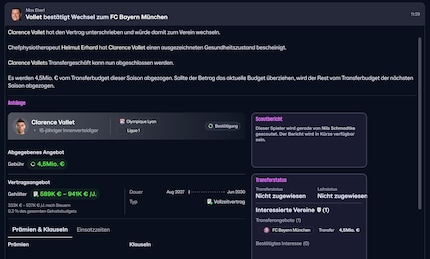
Football Manager isn’t a polished football game. It’s a sports simulation in the best sense of the word, with data, decisions and consequences. Instead of being a superstar on the pitch, you get to be everything behind it – coach, squad builder, psychologist, crisis manager. Unlike EA’s earlier version of a football manager game, whose focus on club administration and infrastructure covered everything from stadium expansion to hotdog stands, Sega’s Football Manager centres upon sporting achievements. The board takes care of major projects – you just request them instead of building them yourself. There’s less spectacle and more tactical substance.
Last year’s Football Manager was cancelled following several postponements. The reason? The switch to Unity, complete with a revised match engine and modernised interface, representing the biggest shake-up in the FM series to date. Sports Interactive explained that due to the «biggest technical and visual advancement in the series for a generation [...] it became unmistakably clear that we would not achieve the standard required, even with the adjusted timeline.»
The question is, is FM 26 worth the wait? That extra year of development should really be noticeable. As a player, you’re entitled to expect at least a decent game. However, the sobering answer to that question is «no». Football Manager 26 is an absolute disaster.
Even as a fan of the series, I can’t sugarcoat that verdict. There’s a sprawling list of problems, my main points of criticism being the user interface and user experience. The basic principle behind the game is the only thing that continues to impress.
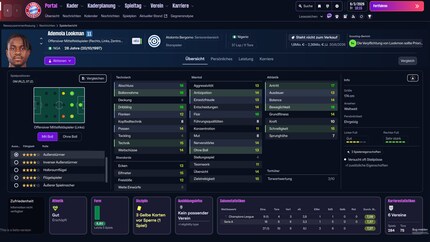
For this review, I played a season with FC Bayern Munich, getting a decent sense of the game over my almost 30 hours of playing time. In my experience, even that’s only enough to scratch the surface of an FM.
The first noticeable failure is the interface. While FM26 appears more current at first glance, a second look reveals the new interface to be surprisingly impractical. There’s been an attempt to make it clearer, but this has made important information disappear. Whereas earlier games had a certain functional straightforwardness that you could read intuitively, FM26 presents as a game that tells you too much and too little at the same time.

In practice, this makes even simple tasks feel cumbersome. If you want to quickly check in on the training progress of your squad and individual players, you often end up two or three levels deep into submenus. Information that was once available at a glance on a compact overview screen is now spread across several screens.
This is even more evident when it comes to employees. There’s no longer a real overview screen giving you details on scouts, analysts or assistant coaches on one page. Instead, you have to click on each one individually, study their attributes, then go back again. As a result, you constantly lose sight of the bigger picture.
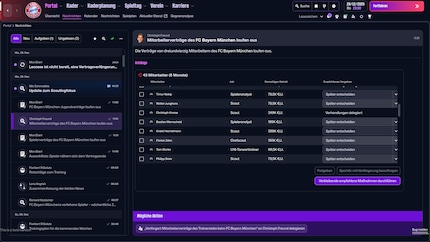
It’s especially annoying that if you want to skip back through longer lists, you don’t end up at your previous place. Instead, you’re always taken back to the top. If you’re working your way through dozens of candidates or staff members, that effectively means having to start all over again. At the end of my first season at Bayern, I had to decide the fate of about 45 employees.
This involved a pop-up system that was more of a hindrance than a help. Instead of making sensible use of the available space, the game feeds you loads of information featured in separate, overlapping windows. Switching between the player profile, scout report and transfer screen soon makes the display feel like a house of cards consisting of panels. This is exacerbated by the sluggishness of the interface. Panel changes take noticeably longer, there are delays in building lists and clicks feel slower than in previous games.
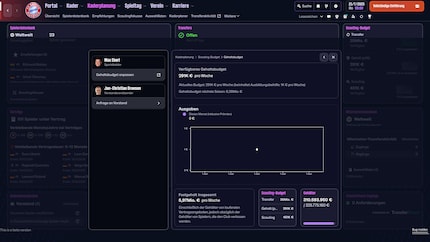
A potential reason behind these issues is the strong focus on consoles, tablets and mobile devices. The new controls have the look of a universal app intended to work on any platform – the kind that often goes hand in hand with simple click surfaces, pop-up windows and tabs with a reduced amount of information.
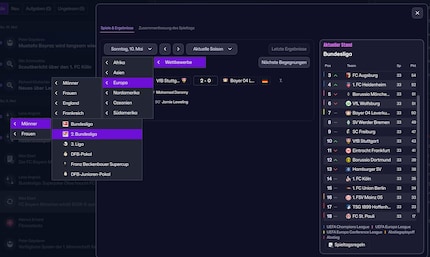
However, the same modification has created unnecessary simplification in the PC version, with numerous intermediate steps that slow down experienced players. The clear, compact overview screen from older versions of Football Manager has been ditched in favour of a touch-friendly interface that massively disrupts a typical desktop workflow.
In terms of content, the interface seems to represent a step backwards, providing less information per glance and requiring more searches. Tables and windows reveal fewer key figures than before and hide important details behind tooltips or icons. The result? An interface that constantly knocks me out of my rhythm. Instead of making quick decisions, I spend too much time navigating the controls. This is precisely where the game’s real user experience issues begin.

These interface weaknesses wouldn’t be half as bad if Football Manager 26 actually ran smoothly during a regular gaming session. However, that’s not the case. The career flow seems slow-moving and fragmented, with constant interruptions.
What FM really thrives on is a a well-rehearsed cycle: check training progress, skim the medical centre, review scout reports, adjust tactics, set up your team, play a match, evaluate it, move on to the next match day. In FM26, this very routine feels like a sequence of obstacles. Although every step works, there’s friction almost everywhere.

This is particularly evident in the line-up. On the Match Day screen, FM26 divides your squad into several logical levels. There’s the pitch with your starting eleven on the left, a narrow bar containing the subs underneath, and a long list of bench players and reserves in table form on the right. That may sound like an overview, but in reality, it’s kind of unwieldy.
Changeovers and the drag-and-drop system don’t work particularly smoothly. In the area on the right, you can only swap a bench player with a starter if you actively pull him down from the bench. The other way round, i.e. simply dragging a player up onto the bench, isn’t possible; the system effectively only allows one drag-and-drop direction.
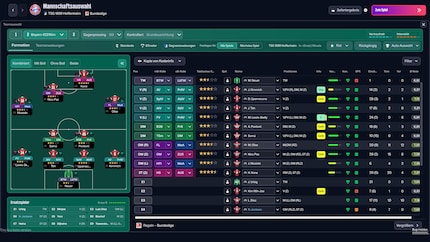
This pattern runs through your entire career, with numerous little niggles adding up. The path from match day to match day is unnecessarily drawn-out, with long message chains slowing down your progress. Every adjustment you make – whether it’s to training, scouting or your match plan – requires more clicks than it really should. Admittedly, the admin you had to do in previous Football Managers was starting to get tedious. This time, though, it’s genuinely unbearable. The same goes for the process running through match day itself. Far too much time passes before you’ve finally clicked through to the game. The developers should really make stuff like that much leaner.
FM26’s UI has gone from being a toolbox to an obstacle. Rather than supporting you, it slows you down.
Once you’ve battled your way through the menus, notifications and line-up screen, there should really be a reward waiting for you on the pitch. After all, Football Manager 26’s revised match engine was one of its main promises. In practice, however, that advancement seems considerably less drastic than the game’s marketing and development time would suggest.
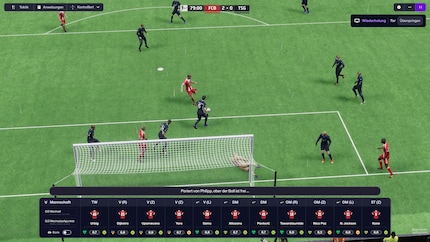
Sure, the presentation’s been improved in some places. Runs are sometimes smoother, challenges seem less wooden, and, for the first time, some combinations look like they could’ve come from a real highlight summary. But the longer I play, the more I get the impression that the matches feel random, not natural.
With Bayern, I’d usually get to control a lot of matches. Instead, I often have encounters that feel like random generators with club crests. Although there’s high possession and plenty of shooting, the action seems sterile. Multiple crosses sail into nothingness. Strikers dribble the ball into opponents instead of going for an obvious space. Centre-backs try to resolve high-pressure situations by passing into the centre – something I’ve seen more frequently in bug videos than actual matches.

What’s more, the match engine feedback is still too basic. Some familiar match analyses and data overviews are missing, while others just seem rudimentary. They don’t help you translate your observations into specific measures often enough. In previous games, that process was much better.
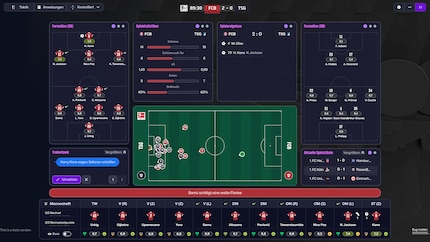
The bottom line is, although the match engine’s been modernised on paper, it doesn’t feel like a massive advancement. It’s okay – sometimes even good – but it’s a far cry from the «biggest advancement in the series» mentioned in the press surrounding the technical update. Most importantly, it doesn’t manage to make up for the sluggish career flow. If the path to kick-off’s tedious, your stadium experience has to be all the more rewarding. However, Football Manager 26 doesn’t provide that.
Of course, no major FM release would be complete without bugs. Football Manager 26’s certainly continued that tradition – albeit in an annoying way rather than a spectacular one. Time and again, I stumble across minor logical failures and inaccuracies, such as repetitive or blatantly wrongly worded notifications.
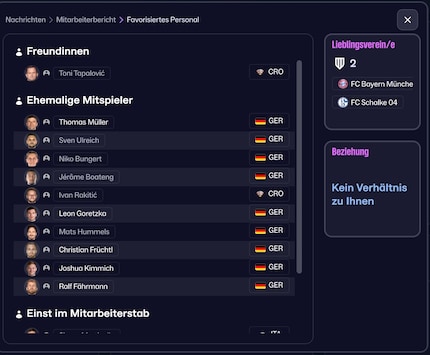
Taken in isolation, none of these errors would be a dealbreaker. On the whole, however, they reinforce the impression I’ve got from the interface and user experience. Rather than a finished product, the game feels more like a build that could’ve used a few more tweaks. Given that it’s had a year-long break and a much-heralded technical revamp, this is seriously unfortunate.
In my opinion, it’s also unacceptable that the game’s missing tried-and-tested features such as taking on a national team. Cup draws only get a cursory mention, while important analysis and management tools have been deleted without replacement.
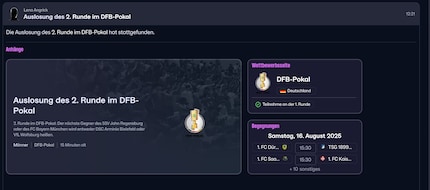
Sega provided me with the PC version of Football Manager 26. The game has been available for PC, PlayStation 5 and Xbox Series X|S since 4 November.
With its new technical foundation, revised match engine and modernised interface, Football Manager 26 should’ve been the reboot. The way I see it, it’s a game that barely lives up to its promises – and, in practice, feels like a clear step backwards. The interface hides information you need continuous access to. Meanwhile, the controls slow you down instead of helping you make decisions more quickly. What’s more, the match engine doesn’t provide the outstanding gaming experience you’d expect as a reward for the slog leading up to kick-off.
The founding principle behind FM is still as solid as ever. That concept of shaping a club over the years, developing talent and building a tactical philosophy still holds up today. However, this principle’s undermined by the way it’s been implemented. After a year-long break and so much hype around the game’s advancement, I’d expected to come to a better verdict than «sometimes okay, but more flop than fun». I’d been expecting a game that’d put me in such a state of flow that I’d play until suddenly noticing the sun had come up outside.
In its current state, Football Manager 26 doesn’t do that for me. Maybe patches will sort a few things out, and I’ll get that sense of flow back at some point in the future. As things stand at the moment, this is the first time in many years that I’ve declined to recommend a new FM. A fact that pains me almost as much as the titles I’ve lost out on during my virtual career.
Pro
Contra
My interests are varied, I just like to enjoy life. Always on the lookout for news about darts, gaming, films and series.
Which films, shows, books, games or board games are genuinely great? Recommendations from our personal experience.
Show all